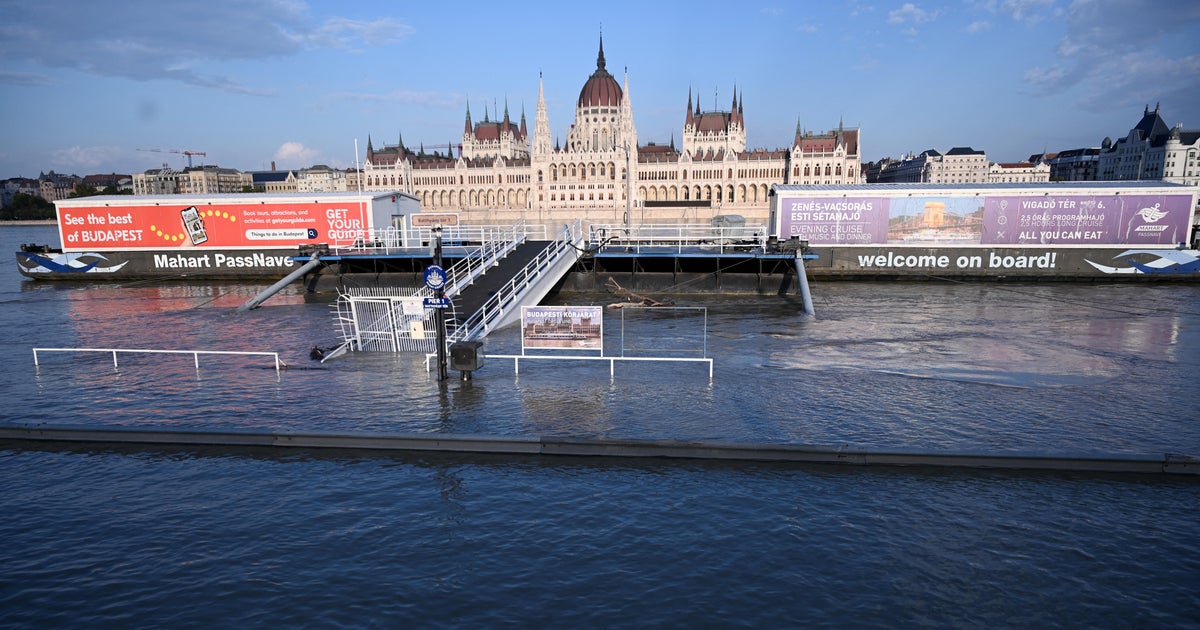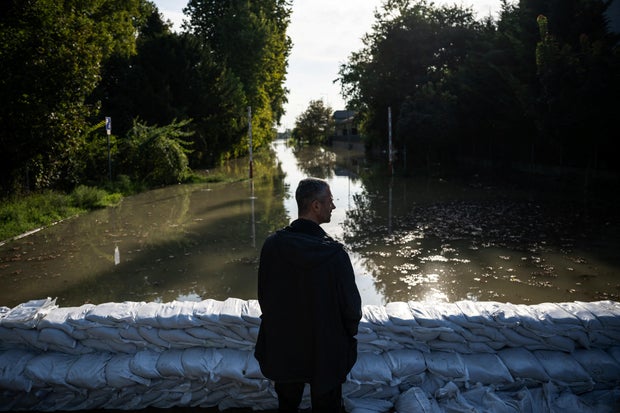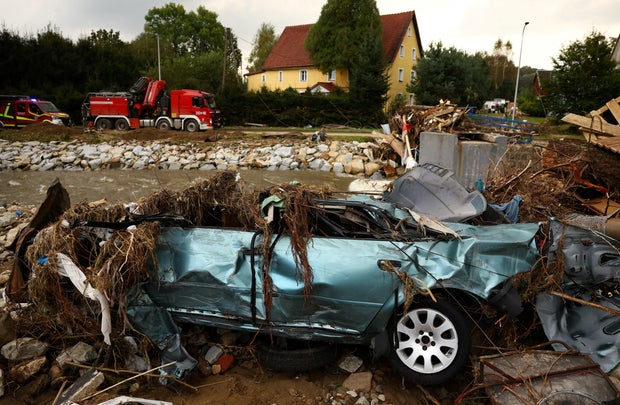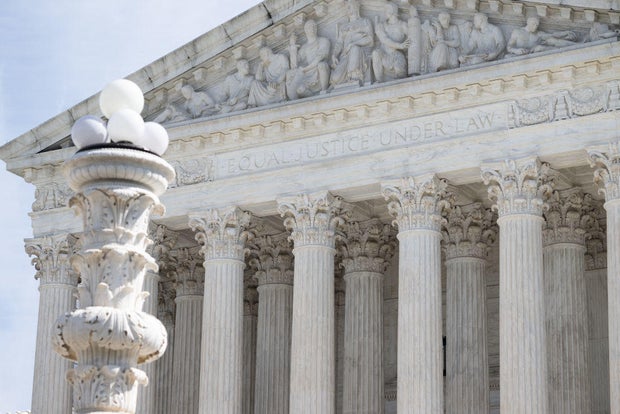CBS News
Flooding in Central Europe blamed for 24 deaths as EU promises $11 billion in emergency repair funding

Warsaw, Poland — European Union chief Ursula von der Leyen on Thursday pledged billions of euros in aid for Central European countries that suffered enormous damage to infrastructure and housing during the massive flooding that has so far claimed 24 lives in the region. Von der Leyen paid a quick visit to a flood-damaged area in southeast Poland and met with heads of the governments of the affected countries — Poland, Austria, the Czech Republic and Slovakia.
She said funds will be made available quickly for infrastructure repair from the EU’s solidarity fund, as well as 10 billion euros ($11 billion) from what is called the cohesion fund — for the most urgent repairs. In a special approach, no co-financing will be required from these countries for the money to be released.
“Here we say it’s 100% European money, no co-financing,” von der Leyen told a news briefing. “These are extraordinary times, and extraordinary times need extraordinary measures.”
Marton Monus/REUTERS
Meanwhile, a massive flood wave threatened new areas and heavy rains also caused flooding and forced the evacuation of some 1,000 people in the northern Italian region of Emilia-Romagna. In Central Europe, the receding waters revealed the scale of the destruction caused by exceptionally heavy rains that began a week ago.
Czech Interior Minister Vit Rakušan said one more person was reported killed on Thursday in the country’s hard-hit northeast, bringing the death toll there to five. There were also seven deaths each in Poland and Romania, and five in Austria — with the overall death toll now at 24.
Authorities deployed troops to help. In the northeast Czech Republic, soldiers joined firefighters and other emergency crews to help with the recovery efforts. Army helicopters distributed humanitarian aid while soldiers were building temporary bridges in place of those that were swept away.
Some 400 people remained evacuated from the homes in the regional capital of Ostrava. In the southwest, the level of the Luznice River reached an extreme high but the evacuation of 1,000 people in the town of Veseli nad Luznici was not necessary for the moment, officials said.
Getty
Cleanup efforts were underway in Austria, where flooding washed away roads and led to landslides and bridge damage. Firefighters and soldiers pumped water and mud out of houses and disposed of damaged furniture, broadcaster ORF quoted fire department spokesperson Klaus Stebal as saying.
The governor of Lower Austria province, Johanna Mikl-Leitner, said reconstruction was expected to take years, according to the Austria Press Agency.
The Vienna public transport company has had to pump almost 1 million liters (260,000 gallons) of water since last weekend. Ten towns and areas were still inaccessible on Thursday, APA reported.
In Hungary, flood waters continued to rise as authorities closed roads and rail stations. Ferries along the Danube River halted.
ATTILA KISBENEDEK/AFP/Getty
In the capital, Budapest, water spilled over the city’s lower quays and threatened to reach tram and metro lines. Some transport services were suspended. Remarkable images showed the water of the Danube creeping up perilously close to the ground floor of Hungary’s Parliament building, which sits directly on its bank.
Further upriver, in a region known as the Danube Bend, homes and restaurants near the riverbanks were inundated.
Nearly 6,000 professionals, including members of Hungary’s water authority and military, were mobilized, and prison inmates were involved in filling sandbags, Prime Minister Viktor Orbán said at a news conference Thursday.
The Danube stood at over 25 feet, approaching the 29.2-foot record set during major flooding in 2013.
In southwestern Poland, the high waters reached the city of Wroclaw and an extended wave was expected to take many hours, even days to pass, exerting pressure on the embankments.
The water level on the Oder River just before Wroclaw was 21 feet, some 6.5 feet above alarm levels but still lower compared to the disastrous flooding in 1997.
Kacper Pempel/REUTERS
In the two most-affected towns, Stronie Slaskie and Ladek-Zdroj, tap water and power were restored, said Gen. Michal Kamieniecki, who was put in charge of the recovery operations there after an emotional appeal to Prime Minister Donald Tusk for help the day before by a young woman identified only as Katarzyna.
As concerns mounted, Tusk invited von der Leyen to Wroclaw to see the situation first hand. Government leaders from the Czech Republic, Slovakia and Austria were also there.
In Italy, rivers flooded in the provinces of Ravenna, Bologna and Forlì-Cesena, as local mayors asked people to stay on the upper floors or leave their houses. Those areas were hit by devastating floods in 2023, when more than 20 rivers overflowed, killing 17 people.
Italy’s vice minister for transport and infrastructure, Galeazzo Bignami, said Thursday that two people were reported missing in Bagnocavallo, in Ravenna province.
At least 800 residents in Ravenna and almost 200 in Bologna province spent the night in shelters, schools and sports centers. Trains were suspended and schools closed while residents were advised to avoid travel.
CBS News
Mexico president blames U.S. for cartel killings as violence surges in Sinaloa after leaders arrested

Mexican President Andrés Manuel López Obrador blamed the United States in part on Thursday for the surge in cartel violence terrorizing the northern state of Sinaloa which has left at least 30 people dead in the past week.
Two warring factions of the Sinaloa cartel have clashed in the state capital of Culiacan in what appears to be a fight for power since two of its leaders were arrested in the United States in late July. Teams of gunmen have shot at each other and the security forces.
Meanwhile, dead bodies continued to pop up around the city. On one busy street corner, cars drove by pools of the blood leading to a body in a car mechanic shop, while heavily armed police in black masks loaded up another body stretched out on a side street of the Sinaloan city.
Asked at his morning briefing if the U.S. government was “jointly responsible” for this violence in Sinaloa, the president said, “Yes, of course … for having carried out this operation.”
The recent surge in cartel warfare had been expected after Joaquín Guzmán López, a son of former Sinaloa cartel leader Joaquín “El Chapo” Guzmán, landed near El Paso, Texas on July 25 in a small plane with Ismael “El Mayo” Zambada.
Zambada was the cartel’s elder figure and reclusive leader. After his arrest, he said in a letter circulated by his lawyer that he had been abducted by the younger Guzmán and taken to the U.S. against his will. Zambada pleaded not guilty last week in New York in a drug trafficking case that accuses him of engaging in murder plots and ordering torture.
On Thursday afternoon, another military operation covered the north of Culiacan with military and circling helicopters.
Eduardo Verdugo / AP
Traffic was heavy in Culiacan and most schools were open, even though parents were still not sending their children to classes. Businesses continue to close early and few people venture out after dark. While the city has slowly reopened and soldiers patrol the streets, many families continue to hide away, with parents and teachers fearing they’ll be caught in the crossfire.
“Where is the security for our children, for ourselves too, for all citizens? It’s so dangerous here, you don’t want to go outside,” one Culiacan mother told the Associated Press.
The mother, who didn’t want to share her name out of fear of the cartels, said that while some schools have recently reopened, she hasn’t allowed her daughter to go for two weeks. She said she was scared to do so after armed men stopped a taxi they were traveling in on their way home, terrifying her child.
“Hugs not bullets”
During his morning news briefing, López Obrador had claimed American authorities “carried out that operation” to capture Zambada and that “it was totally illegal, and agents from the Department of Justice were waiting for Mr. Mayo.”
“If we are now facing instability and clashes in Sinaloa, it is because they (the American government) made that decision,” he said.
He added that there “cannot be a cooperative relationship if they take unilateral decisions” like this. Mexican prosecutors have said they were considering bringing treason charges against those involved in the plan to nab Zambada.
He was echoed by President-elect Claudia Sheinbaum, who said later in the day that “we can never accept that there is no communication or collaboration.”
It’s the latest escalation of tensions in the U.S.-Mexico relationship. Last month, the Mexican president said he was putting relations with the U.S. and Canadian embassies “on pause” after ambassadors criticized his controversial plan to overhaul Mexico’s judiciary by requiring all judges to stand for election.
Still, the Zambada capture has fueled criticisms of López Obrador, who has throughout his administration refused to confront cartels in a strategy he refers to as “hugs not bullets.” On previous occasions, he falsely stated that cartels respect Mexican citizens and largely fight amongst themselves.
While the president, who is set to leave office at the end of the month, has promised his plan would reduce cartel violence, such clashes continue to plague Mexico. Cartels employ an increasing array of tactics, including roadside bombs or IEDs, trenches, home-made armored vehicles and bomb-dropping drones.
Last week, López Obrador publicly asked Sinaloa’s warring factions to act “responsibly” and noted that he believed the cartels would listen to him. But the bloodshed has only continued.
In an strange twist, last month Mexican prosecutors said they were bringing charges against Guzmán for apparently kidnapping Zambada — but they also cited another charge under an article of Mexico’s criminal code that defines what he did as treason.
Nowhere in the statement does it mention that the younger Guzmán was a member of the Chapitos — “little Chapos” — faction of the Sinaloa cartel, made up of Chapo’s sons, that smuggles millions of doses of the deadly opioid fentanyl into the United States, causing about 70,000 overdose deaths each year. According to a 2023 indictment by the U.S. Justice Department, the Chapitos and their cartel associates used corkscrews, electrocution and hot chiles to torture their rivals while some of their victims were “fed dead or alive to tigers.”
El Chapo, the Sinaloa cartel’s founder, is serving a life sentence in a maximum security prison in Colorado after being convicted in 2019 on charges including drug trafficking, money laundering and weapons-related offenses.
Last year, El Chapo sent an “SOS” message to Mexico’s president, alleging that he has been subjected to “psychological torment” in prison.
CBS News
Israel and Hezbollah keep up attacks despite U.S. warning against escalation after pagers explode

Beirut, Lebanon — The White House has warned both Israel and the Iran-backed Hezbollah group against “escalation of any kind” following this week’s synchronized pager and walkie talkie explosions targeting Hezbollah members, but overnight, Israeli warplanes carried out dozens of strikes across southern Lebanon, and Hezbollah has continued firing back.
There were loud explosions and fires ignited by what the Israel Defense Forces said were strikes targeting hundreds of active Hezbollah rocket launchers in Lebanon early Friday.
It appeared to be one of the most extensive Israeli attacks on Hezbollah’s stronghold in southern Lebanon since the two sides started trading fire 11 months ago, with Hezbollah claiming its rocket attacks on northern Israel as support for its allies Hamas and the Palestinian people.
Israel Defense Forces/Handout/REUTERS
Hezbollah struck northern Israel again in a counterattack, killing at least two soldiers, according to Israeli officials.
The deadly escalation in violence followed a televised address from a weary-looking Hassan Nasrallah — the leader of Hezbollah — who admitted this week’s pager and walkie talkie explosions had delivered a “severe blow” to the powerful group, which like Hamas has long been designated a terrorist group by Israel and the U.S.
Nasrallah accused Israel of not only violating “all red lines” with the explosions, but of a “declaration of war.”
Israel has not publicly claimed the complex attacks, but CBS News learned that American officials were given a heads-up by Israel about 20 minutes before the operations began in Lebanon Tuesday, though there were no specific details shared about the methods to be used.
For two terrifying days in Lebanon, thousands of low-tech communications devices — many used by Hezbollah members — exploded simultaneously across the country, wounding over 3,000 people and killing at least 37, including children, according to Lebanon’s health ministry.
In his address, Nasrallah vowed that Israel would not achieve its goal of enabling the return of tens of thousands of people displaced from their homes in northern border towns. Even as he spoke on Thursday, however, sonic booms echoed above Beirut as Israeli fighter jets roared over the city, flexing Israel’s military might.
But as the U.S. warning Thursday indicated, the next moves — be they further retaliation from Hezbollah or ground operations by the IDF against the group — could have major consequences.
“Ultimately, if they [Israel] do invade, they would have to occupy” southern Lebanon, regional analyst Makram Rabah told CBS News. “This would lead to a kind of a slow, depleting war for Israel, and this would, more importantly, legitimize Hezbollah.”
But hundreds of Hezbollah fighters were likely injured by the explosives attacks, which almost certainly left the group’s communications networks in complete disarray. And despite warnings from Israel’s defense chief of “a new phase” in the country’s war with Iran’s so-called proxy groups, and one IDF division already being transferred there from Gaza, there’s also been no major Israeli build-up of forces or hardware along the Lebanon border seen yet.
So, the prospect of all-out war between Hezbollah and Israel — which could potentially put U.S. forces across the Middle East in direct danger — may not be as close as some fear.
contributed to this report.
CBS News
Trump left his mark on the federal bench. Can Biden match his number of judicial nominations?

Washington — As President Biden prepares to close out his four years in the White House, he is on track to match or even surpass the former President Donald Trump’s total number of judicial confirmations.
Appointments to the federal bench have taken on added importance in recent years as courts have played a greater role in American life as the adjudicators of disputes over hot-button issues like abortion, immigration and the environment.
Trump closed out his single term with 234 appointments to Article III courts, which include the Supreme Court, federal courts of appeals, district courts and U.S. Court of International Trade. His impact on the federal bench has been quickly realized, with Trump-appointed judges overseeing closely watched cases involving the abortion pill, the Biden administration’s immigration policies, student loan forgiveness programs and LGBTQ rights.
Now Mr. Biden, a former chairman of the Senate Judiciary Committee, is closing in on his predecessor’s 234 judicial appointments, as the Senate continues to churn through confirmations in the weeks leading up the November election.
“The American people and senators and members of Congress and presidents all realize how important the courts are, especially recently,” said Carl Tobias, a law professor at the University of Richmond who focuses on federal judicial selection. “They’ve given courts a lot of salience, and so I think they’re more and more taken into account as the third branch of government and an important branch, and you need more than just Congress and the president to do things.”
Presidents and the Senate, he said, are “quantitatively and qualitatively wanting to get the most and the best judges.”
Biden’s judicial nominations
SAUL LOEB/AFP via Getty Images
With four months left in his presidency, 212 of Mr. Biden’s judicial nominations have won approval by the Senate, a figure that includes Justice Ketanji Brown Jackson’s historic confirmation to the Supreme Court.
Among those 212 judges are 44 that joined the appeals courts and 165 on the district courts. And with 29 nominees pending in the Senate, Mr. Biden could close out his presidency with 241 overall judicial appointments if they all are confirmed. Another 28 seats are currently open without nominees from the White House, according to the Judicial Conference, and many are from states with two Republican senators. The White House typically consults with home-state senators on nominations, though they can block a nominee to a district court.
“Every judicial confirmation makes an enormous difference to the courts to which these judges will join,” a White House official told CBS News.
The official said while there is a “real possibility” of Mr. Biden having more of his judicial nominees approved by the Senate than Trump, the number is “less important than what it signifies, which is confirmations of the most demographically and professionally diverse nominees who understand the power of the courts and their role within the system of justice.”
While Mr. Biden is poised to top Trump in total judges named to the federal bench, he’s unlikely to match his predecessor’s appointments to the 13 courts of appeals before leaving office. The former president had 54 of his nominees to those courts approved by the Senate, compared to Mr. Biden’s 44. And with just five nominations pending, the president will likely fall short of Trump’s total.
Trump, though, had the upper hand for making a mark on the federal appeals courts when he came into office, inheriting 17 vacancies after confirmations in the Republican-led Senate ground to a halt in the final two years of President Barack Obama’s term. When Mr. Biden assumed the presidency, there were just two open appeals court seats.
Both presidents, though, put an emphasis on filling those vacancies first.
“The decisions of district judges are binding on no other judges, while the decisions of the courts of appeals are theoretically precedents for all the district judges in the circuit,” said Russell Wheeler, a nonresident senior fellow at the Brookings Institution who tracks nominations. “When District Judge Jones makes a decision, it’s binding on the parties, but doesn’t bind Judge Smith. But when Circuit Judge Jones makes a decision along with two others on the panel, that’s the law of the circuit.”
Plus, the appeals courts are the “last stop in the process” for most parties, he said, especially since the Supreme Court agrees to review so few lower court decisions.
The Republican-led Senate also continued to hold votes on 14 of Trump’s judicial picks after he lost the 2020 election to Mr. Biden, the first time a defeated president had a judge confirmed during a lame-duck session since 1980, according to Wheeler.
Democrats lambasted the confirmations at the time as a violation of a “long and established tradition” of halting consideration of judicial nominees after Election Day, but the GOP’s willingness to break with that practice four years ago could benefit Mr. Biden during the upcoming lame-duck session.
“The precedent is there, the nominees are there, the will is there, so I would anticipate that, taking a page from the McConnell playbook, that confirmations will continue in the lame-duck,” the White House official said, referring to former Senate Majority Leader Mitch McConnell. The Republican senator played a crucial role in the confirmations of Trump’s judicial picks.
Beyond the total number of Mr. Biden’s judicial nominations, the president has aimed to diversify the federal bench. He has repeatedly emphasized his goal of ensuring the judiciary reflects the diversity of the American people, and has worked to name judges of varying personal and professional backgrounds.
Mr. Biden set a record for the largest number of nominees to the appeals courts who worked as public defenders. More than 40% of those with lifetime appointments served as public defenders or civil rights lawyers, or worked to protect civil and human rights, according to a May memo from the Leadership Conference on Civil and Human Rights highlighting the president’s 200th judge.
Mr. Biden also notched another milestone when the Senate confirmed Mary Kathleen Costello to the federal bench this week. She became the 12th openly LGBTQ judge confirmed during his administration, surpassing Obama’s record of 11. He named the first Black woman to the nation’s highest court with his selection of Jackson, and has named more Black judges than any of his predecessors in one term.
Senate Majority Leader Chuck Schumer told Democrats in a letter earlier this month that confirming more of Mr. Biden’s judicial nominees is a priority for the coming weeks. But the upper chamber’s slim margins could complicate their efforts.
Vice President Kamala Harris, who has cast tie-breaking votes for at least three candidates to the federal judiciary, is on the campaign trail working to defeat Trump in November, and five Democratic senators are in tight races to hold onto their seats. Democrats and four independents who typically vote with the party hold 51 seats to Republicans’ 49, though one of those GOP senators, JD Vance, has been absent from the Senate campaigning for the vice presidency.
“On paper, Biden should be able to overall in lower court judges meet Trump,” Wheeler said. “Whether the closeness in the Senate makes that difficult is going to be the $64 question.”















